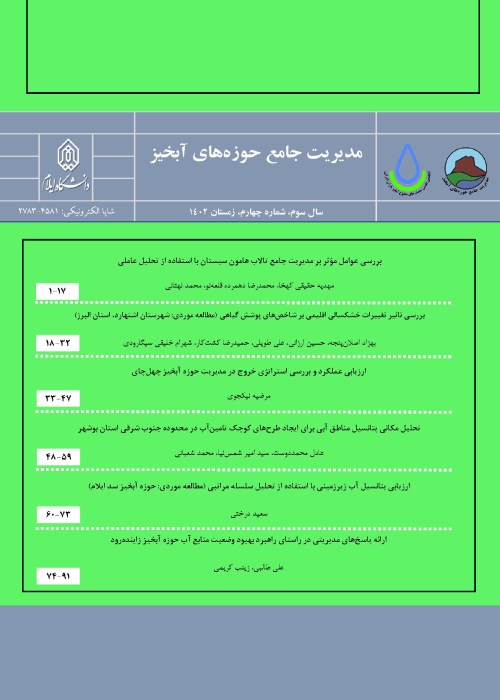Performance Comparison of Two Activation Functions Namely Sigmoid and Hyperbolic Tangent in Artificial Neural Networks for Regional Analysis of Flow Duration Salt Lake Curve in the Watershed, Iran
The unavailability, inadequacy and low quality of Dubai observational data is one of the problems of water resources management, This factor has made water resources management projects difficult. Collecting information requires hydrometric stations, which are expensive to build, and take a long time to collect information. This requirement is therefore recognized by the International Hydrological Association. Prediction in watersheds without statistics has been adopted as a research agenda for the coming decades. In addition, many watersheds in the world have statistical shortcomings. Due to human intervention, it is very difficult to predict in these watersheds. To solve this problem, hydrologists use a tool called area analysis. Due to the complexities related to the emergence of flow continuity, one of the ways to study the variables that cause it, is using an artificial neural network. Most artificial neural network researchers believe that artificial neural networks perform well in investigating unknown and complex issues for two main reasons: First, they have a good relationship between input and output by having pattern recognition capabilities. Second, they are less sensitive to errors between data input and output than other models.
This study aims to evaluate the artificial neural networks in the analysis of the flow continuity curve region using two functions of sigmoid transfer and hyperbolic tangent in the hidden layer and linear transfer function in the output layer. For this purpose, 33 watersheds in the area of Salt Lake Lake were selected according to the length of the statistical period and the minimum of human activities. Independent variables were considered. Using factor analysis, six factors of area, average height, length of main waterway, drainage density, percentage of permeable formations and percentage of rangeland lands were selected. In order to select suitable hydrometric stations, daily flow statistics of all hydrometric stations of the Salt Lake watershed were prepared by Iran Water Resources Research Company (Tamab). Then, the duration of daily discharge statistical period of all hydrometric stations was extracted. Suitable stations were selected according to the appropriate common statistical length and the absence of a diversion dam and upstream dam. Drought threshold discharge percentages were then extracted using daily discharge statistics by calculating the probability percentage through the Weibull relation in Excel 2010 software.
In this study, which was performed in a number of Salt Lake watersheds for regional analysis of the flow continuity curve, we compared the estimation of different flow rates of the flow continuity curve using artificial neural shock with two functions of sigmoid transfer and hypermolic tangent in the hidden layer and the linear function in the output layer. Using the results of factor analysis, six variables of area, average height, length of main waterway, drainage density, percentage of permeable formations and percentage of rangeland lands were selected. In the next step, by changing the type of transmission function in the hidden layer in the multilayer perceptron artificial neural network to analyze the region of the flow continuity curve, it was determined that the sigmoid transfer function is more efficient than the hyperbolic tangent transfer function in most flow continuity flows. Also, the artificial neural network has a high efficiency in estimating the flow continuity curve, the root index value of the mean square error is between 0.01 to 1.92 cubic meters per second and the Nash-Sutcliffe efficiency coefficient is between 0.40 and 0.97 in the discharges.
The results showed that in flows 2, 10, 20, 25, 33.3, 50, 75, 90 and 92% of sigmoid function in the hidden layer with coefficients of explanation 0.88, 0.55, 0.78, 0.60, respectively. , 0.80, 0.63, 0.58, 0.47 and 0.41; The root mean square error is 0.01, 1.92, 1.68, 1.11, 1.78, 0.98, 0.17, 0.21 and 0.21 cubic meters per second and the coefficient of instability is 0.89, 0.40, 0.97, 0.47, 0.84, 0.78, 0.70, 0.93 and 0.41 and in 15 and 30% discharges of hyperbolic tangent function in the hidden layer with coefficient of determination of 94.94, respectively. 0. and 0.80, the root mean square error of 0.40 and 1.16 cubic meters per second and the efficiency coefficients of 0.70 and 0.86 have higher accuracy In general the artificial neural network has a high efficiency in estimating the flow continuity curve.
- حق عضویت دریافتی صرف حمایت از نشریات عضو و نگهداری، تکمیل و توسعه مگیران میشود.
- پرداخت حق اشتراک و دانلود مقالات اجازه بازنشر آن در سایر رسانههای چاپی و دیجیتال را به کاربر نمیدهد.



